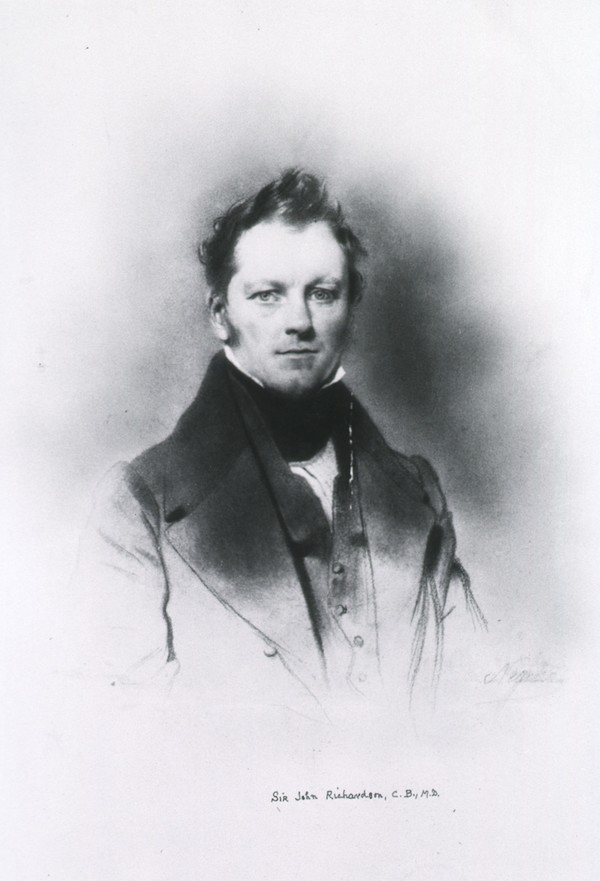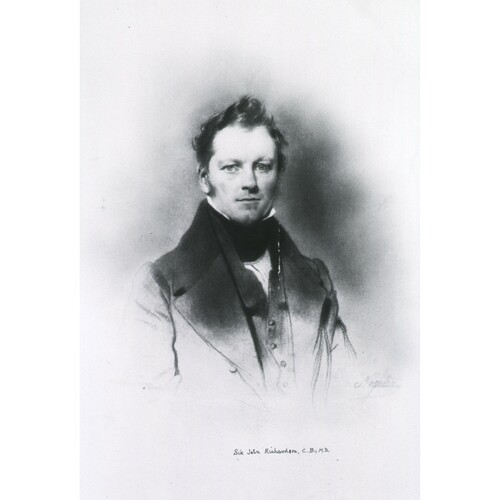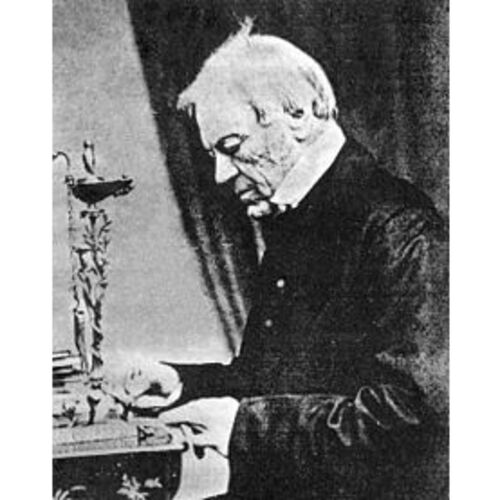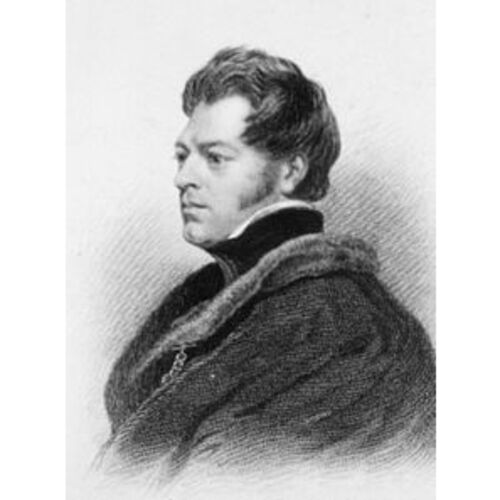
Source: Link
RICHARDSON, Sir JOHN, surgeon, explorer, natural historian, and ichthyologist; b. 5 Nov. 1787 in Dumfries, Scotland, eldest of 12 children of Gabriel Richardson and Anne Mundell; m. first in 1818 Mary Stiven (Stivens) of Leith, Scotland, and secondly in 1833 Mary Booth of Stickney, England, by whom he had seven children, and thirdly in 1847 Mary Fletcher of Edinburgh; d. 5 June 1865 at Grasmere, Westmorland, England.
John Richardson’s father was a prosperous brewer, provost of Dumfries for one term, and a magistrate for many years. Robert Burns was a close friend of the family and influenced John towards literary tastes that lasted all his life. Burns’ oldest son and John Richardson attended the Dumfries Grammar School together. John always liked vigorous activity and outdoor life, encouraged by holidays near the Solway Firth and in the Galloway Mountains.
At age 14 he was apprenticed to his uncle James Mundell, a surgeon in Dumfries, and later to Dr Samuel Shortridge. He attended the medical school of the University of Edinburgh from 1801 to 1804, studying botany, geology, and Greek in addition to the usual subjects: anatomy, chemistry, materia medica, and therapeutics. From 1804 to 1806 he was a house surgeon at the Dumfries and Galloway Royal Infirmary, and in 1806–7 completed his qualification at Edinburgh. His teachers at Edinburgh included some famous figures in a period when its medicine was the model for the world.
Upon obtaining his licence at Edinburgh, Richardson volunteered for the Royal Navy, went to London, became a fellow of the Royal College of Surgeons, and was gazetted to his first ship, at Deptford (London). During sea duty in the Napoleonic wars, 1806–14, he was on six ships in succession and saw action in the Baltic, off Portugal, in the Mediterranean, and off Africa. In 1814 Richardson was appointed surgeon to the Royal Marines in North America. He joined them at Halifax, and was with Sir George Cockburn off the coast of Georgia when Cumberland Island and St Mary’s were captured.
After the War of 1812–14 Richardson went on half pay and returned to Edinburgh to complete his doctorate. Besides medical subjects, he took botany and mineralogy with Robert Jameson, the geologist. He graduated md in 1816, offering a thesis on yellow fever, with which he had had experience in Africa and North America. He set up a practice in Leith, which was not successful because of the post-war surplus of physicians. Here he married, and started a lasting friendship with Dr Francis Boott, the physician and botanist.
Richardson’s Arctic service began in 1819 when he was assigned to John Franklin*’s first expedition as surgeon and naturalist. He then met Sir Joseph Banks* and Dr John Edward Gray (of the British Museum), who became his collaborator and friend for life. The Franklin party, which also included two midshipmen, George Back* and Robert Hood*, and John Hepburn, seaman, went to Montreal, then to Cumberland House on the Saskatchewan River, where they wintered in 1819–20. Travelling 1,350 miles in 1820, they wintered at Fort Enterprise on Great Bear Lake. The summer of 1821 took them by canoe down the Coppermine River to its mouth at the Arctic Ocean and from there east 6 ½° by way of Bathurst Inlet and Melville Sound. On their return to Fort Enterprise they suffered from famine and cold, and would have perished except for the efforts of Richardson and Hepburn. Richardson felt compelled in defence of the weakened party to execute one of the voyageurs who had murdered Hood. Thanks to a difficult winter trip by Back in search of Indians, they were rescued by the Indian Akaitcho and brought to Fort Providence. In June 1822 they proceeded to Great Slave Lake and York Factory and then returned to England, having travelled some 5,550 miles in North America, much of it through unexplored country.
Richardson was granted leave to write three sections of Franklin’s narrative of the expedition, the main one on zoology, and lesser ones on the geognostical material and the aurora. In Edinburgh he also worked up the section on mammals and birds for the journal of William Edward Parry*’s second Arctic voyage (1824).
In 1824 Richardson went on detached service as surgeon, naturalist, and second in command on Franklin’s second Arctic expedition; the group travelled overland from New York to Albany, Niagara, Fort William (Thunder Bay, Ont.), Fort Chipewyan, Great Slave Lake, the Mackenzie River, and Fort Franklin on Great Bear Lake, where they wintered. In 1826 Thomas Drummond*, who was assistant naturalist, explored the natural history of the Rocky Mountains, while Franklin and Richardson went to the mouth of the Mackenzie River. Franklin then explored the coast westward; Richardson, working in two boats with 11 men, mapped the coast eastward to the Coppermine River, some 900 miles. Regaining Fort Franklin, he made a canoe survey of the shores of Great Slave Lake and wintered at Carlton House. After the party’s return to England by way of New York, with important collections, Richardson was granted leave to work on the account of his part in Franklin’s expedition.
Richardson became chief medical officer at the Melville Hospital, Chatham, in 1828 and remained there for ten years. There, after his first wife’s death, he married Mary Booth, a niece of Sir John Franklin. His greatest scientific book, the Fauna Boreali-Americana . . . , was published in four volumes, 1829–37, with William Swainson as collaborator on birds and the Reverend William Kirby on insects. Richardson was solely responsible for quadrupeds and fish. The work established him as one of the foremost biologists of his time.
In 1838 Richardson was assigned as senior physician to the Royal Naval Hospital at Haslar, near Portsmouth, and lived there for the remaining 17 years of his naval career. Here his second wife died and his marriage to Mary Fletcher occurred. At the time of his appointment Haslar Hospital was the largest naval hospital in the world and the biggest brick building in Europe. It had a reputation for good care of patients and outstanding clinical research. Haslar was headed in these years by a captain superintendent who was a naval line officer, not a medical man, with his own staff, and the senior medical officer was an inspector of hospitals and fleets, with his own professional staff. For several years Richardson had as captain superintendent the Arctic explorer Sir William Edward Parry, his close personal friend, and Haslar Hospital went well. Before and after Parry, the incumbents were not nearly so congenial.
Almost from the beginning of his stay at Haslar, Richardson had the responsibility for building up a library and museum. The museum became well known in and outside navy circles as an important centre for research in natural history and comparative anatomy. During the mid 19th century the Royal Navy sent many ships on geographical exploration. Their surgeons, often trained in natural history at Haslar Hospital under Richardson, sent back specimens of plants and animals, and the museum had an unparalleled collection of type specimens first described by Richardson. Alone, or in collaboration with others, he wrote papers and books based on the voyages and the specimens sent back by expeditions including those of Frederick William Beechey*, James Clark Ross, and Edward Belcher*.
Richardson made a last trip to the Canadian Arctic in 1848 when he had reached the zenith of his naval career and was 60 years old. In 1845 Franklin had sailed on his last Arctic expedition in command of Erebus and Terror. Richardson did not accompany him, partly because of important duties at Haslar Hospital. When, however, in 1848 fears for Franklin’s safety forced the Admiralty to investigate, Richardson volunteered to look for his old colleague, and was named to command a search party with Dr John Rae*, a chief factor of the Hudson’s Bay Company, and also skilled in Arctic travel. Their expedition started from Liverpool in March 1848 and proceeded to the estuary of the Mackenzie River in August by way of New York, Montreal, Fort William, Norway House on Lake Winnipeg, and Cumberland House. They next travelled by boat to Wollaston Land and Cape Kendall, and abandoned their boats at Icy Cove. They went overland to Fort Confidence on Great Bear Lake to winter. Extensive measurements were made of meteorological phenomena, including temperature, wind, and magnetic variations. In the spring of 1849 Richardson returned to England leaving Rae in command. As a search for Franklin this expedition was unsuccessful; no traces of the ships were found. Not until Rae’s next trip in 1853 were the first definite relics obtained and the mystery of Franklin’s fate solved. But Richardson’s last expedition, as described in An Arctic searching expedition . . . (1851), was a model. Excellent arrangements for all phases of travel, especially food, shelter, and means of travel, prevented any privation, illness, or injury. The book dealt at considerable length with the ethnography of various Indian tribes and with the physical geography, geology, fauna, and flora of northern America.
After 48 years as a naval surgeon, Richardson retired from active duty in 1855, his age preventing his appointment as director general of the Medical Department of the Royal Navy. He and his family moved to Westmorland, and he lived his last ten years in Grasmere, at Lancrigg, originally a farmhouse, which his wife inherited. In retirement he remained busy. On Arctic matters the Admiralty often turned to its experienced Arctic officers, including Richardson, Francis Beaufort, Beechey, Back, Parry, Edward Joseph Bird, and James Clark Ross. Although never formally organized as such, the group came to be known as the “Arctic Committee” or the “Arctic Council” because of their consultative value. Richardson was also used by parliamentary committees, for example when the future of the HBC was under scrutiny in 1857. He acted as an expert witness on the geography of the Arctic, its past governance, and its future in agriculture and industry.
He continued to write in the field of ichthyology and polar subjects, publishing a number of books and articles. Being away from libraries and collections, he eventually gave up natural history and became a reader for the Philological Society’s new dictionary, which became the Oxford English dictionary.
Sir John Richardson has to be judged in three careers: naval surgery, Arctic exploration, and biology. His chief contributions to naval surgery were three. First, he improved the standards of the nursing staff, Florence Nightingale being his friend and adviser in this effort. Second, he improved the care of the mentally ill, by converting it from restraint to regular ward-care along humane lines. Third, he was a pioneer in the use of general anaesthesia in naval surgery shortly after ether and chloroform were first used.
Richardson displayed both physical and mental qualities that place him high in the ranks of explorers of Canada. He was a man of great stamina, even into his 70s, and he had an unswerving resolution, a quality which saved Franklin’s first overland Arctic expedition. Meticulous planning characterized his field work. Richardson’s surveys along the Arctic coast were substantial contributions to the discovery of the northwest passage. He was an all-round natural historian and contributed important observations in geology, meteorology, mineralogy, and glaciology as well as in botany and zoology.
The two monumental works, Fauna Boreali-Americana . . . , edited by Richardson, and its companion Flora Boreali-Americana . . . , edited by Sir William Jackson Hooker, were based largely on specimens collected by Richardson in Franklin’s first expedition and by Richardson and Drummond in the second. These books, primary sources for North American biology, opened up a whole new field of geographical natural history, that of the Arctic region, and were strong influences toward an ecological approach to natural history. Antarctic biology also received Richardson’s attention in The zoology of the voyage of H.M.S. Erebus and Terror, under Sir James Clark Ross . . . during the years 1838 to 1843 . . . (2v., London, 1844–75), in collaboration with John Edward Gray and others.
The unique nature of the Haslar Hospital and the specimens brought back to it from discovery ships made Richardson the foremost ichthyologist of his time. From seas as far away as Australia, China, and Japan virtually every shipment contained fish not yet examined by taxonomists. The numbers of species described by Richardson, and the numbers of type specimens in the museum, were enormous. Although Richardson never held an academic post, his general influence on younger scientists was powerful, and his work in biology and geology has been considered important for Canadian science. Some of the young naval surgeons who were assigned to ships of discovery with duties as naturalists and who had got their training at Haslar Hospital from Richardson became, like Thomas Henry Huxley, professional biologists.
Richardson was a friend and colleague to many of the famous investigators of the day, including Richard Owen, Huxley, William Jackson Hooker and his son Joseph Dalton, Charles Lyell, Georges Cuvier, Louis Agassiz, John James Audubon, and Charles Darwin. While writing The zoology of the voyage of H.M.S. Beagle . . . in 1836, Darwin turned to Richardson for advice on matters of Arctic ecology and the taxonomy of Arctic animals. Richardson’s contribution was mainly in providing information in areas where Darwin himself was not strong. He was a descriptive, not an experimental or theoretical biologist. His papers are characterized by wide learning, a concise, clear style, attention to accuracy in all details, elegance of illustration, and not much theorizing. He was the right man in the right place to contribute notably to systematics and taxonomy, and thus to the early development of Darwin’s ideas.
In his Victorian time he held a respected place. His early work won him election in 1825 to the Royal Society of London. He was knighted in 1846 and made a cb in 1850. His hospital assignment enabled him to continue a highly productive scientific career, for which he received the royal medal of the Royal Society in 1856. Numerous animal species, several plant species, and a Canadian river, lake, bay, and mountain are named in his honour.
[Sir John Richardson’s writings are numerous. A complete bibliography of his printed books was published by M. F. Curvey and R. E. Johnson and of his articles in learned journals by M. A. Huntley et al. in the Soc. for the Bibliography of Natural History, Journal (London), 5 (October 1969), 202–17; 6 (April 1972), 98–117. The Burgh Museum (Dumfries, Scotland), Crombie bequest, has many letters of the Richardson family in Scotland; many letters from Richardson’s friends, family, and professional colleagues may be found in the private Richardson-Voss collection owned by John Voss (1972), Chesham Bois, Amersham, Eng. The PRO, Adm. 8/196, contains Richardson’s navy service record from April 1807 to June 1855. The only full-length biography of Richardson was written by the Reverend John MacIlraith, a nephew by marriage. The Life of Sir J. Richardson . . . (London, 1868) is weak on scientific matters but the author had access to a wealth of family letters and papers. r.e.j]
DNB. C. S. Houston and M. G. Street, The birds of the Saskatchewan River, Carlton to Cumberland (Regina, 1959). J. J. Keevil et al., Medicine and the navy, 1200–1900 . . . (4v., Edinburgh and London, 1957–63), IV, 70. Rich, History of HBC, II. J. B. Richardson, “A visit to Haslar, 1916,” Royal Naval Medical Service, Journal (London), 2 (1916), 329–39. Humphrey Rolleston, “Sir John Richardson, C.B., M.D., L.L.D., F.R.S., the naturalist of the Naval Medical Service,” Royal Naval Medical Service, Journal, 10 (1924), 160–72. D. A. Stewart, “Sir John Richardson, surgeon, physician, sailor, explorer, naturalist, scholar,” Canadian Medical Assoc., Journal (Toronto), 24 (1931), 1–15.
Cite This Article
R. E. Johnson, “RICHARDSON, Sir JOHN,” in Dictionary of Canadian Biography, vol. 9, University of Toronto/Université Laval, 2003–, accessed December 19, 2025, https://www.biographi.ca/en/bio/richardson_john_9E.html.
The citation above shows the format for footnotes and endnotes according to the Chicago manual of style (16th edition). Information to be used in other citation formats:
| Permalink: | https://www.biographi.ca/en/bio/richardson_john_9E.html |
| Author of Article: | R. E. Johnson |
| Title of Article: | RICHARDSON, Sir JOHN |
| Publication Name: | Dictionary of Canadian Biography, vol. 9 |
| Publisher: | University of Toronto/Université Laval |
| Year of publication: | 1976 |
| Year of revision: | 1976 |
| Access Date: | December 19, 2025 |





